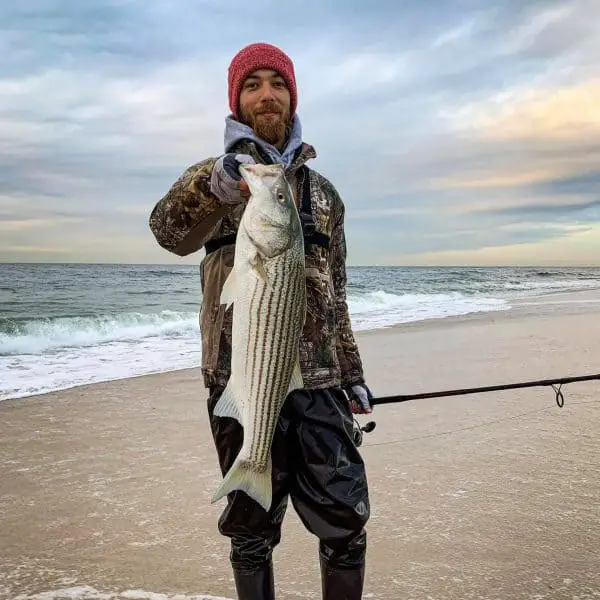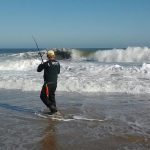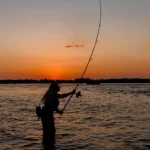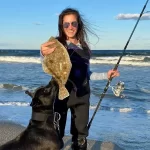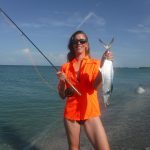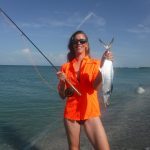Surf Fishing for Striped Bass – Pro Tips!
This article will thoroughly cover surf fishing for striped bass. Striped bass are the most popular inshore saltwater species from South Carolina to New England.
Surf fishing for striped bass is a very popular sport that takes place all along the East coast of the United States. Striped bass, Morone saxatilis, are the most targeted species for anglers surf fishing the coastal beaches. Specialized tackle and techniques are used to hook them!
Surf fishing may seem like a pretty basic fishing technique where anglers simply stand on the beach and cast out into the ocean. However, this is far from the reality. Surf fishing is very nuanced; little changes and tactics make a big difference in angling success. All of the information needed to go surf fishing with striped bass will be in this article.
Striped bass surf fishing tackle
Anglers surf fishing for striped bass will need some specialized equipment. The main difference is the length of the fishing rods. Long rods are required in order to make long casts as well as keeping the line up over the breaking waves. Spinning tackle is mostly used and is the best choice for anglers new to the sport. Experienced anglers use conventional tackle with great success.
Two different rod and reel combinations will be required to efficiently go surf fishing for striped bass. The requirements for both types of fishing are a bit different. One is for casting artificial lures and the other for casting heavy natural baits. The outfit for casting lures will usually be a bit lighter than the heavier outfit for casting cut baits.
Best rod and reel for casting lures
Anglers casting lures need an outfit heavy enough to handle heavy lures while being light enough to cast repeatedly. The best rod and reel combination for surf fishing for striped bass is a 10 foot rod paired with a 6000 series reel and spooled up with 30 pound braided fishing line. This outfit will allow anglers to cast lures without getting exhausted while still handling the heavier lures and big surf. If anglers only want to purchase one surf fishing rod and reel, this would be a perfect combination.
Erica and Paulie highly recommend a 10 foot Tsunami Airwave Elite rod paired with a Penn Spinfisher 6 5500 spooled reel spooled up with 30lb braid. This outfit has served them well, especially for casting artificial lures.
Click links to shop Amazon for Tsunami rods and Penn reels
“Fishing Lido Key is a participant in the Amazon Associates Program, an affiliate advertising program designed to provide a means for sites to earn advertising fees by advertising and linking to Amazon. As an Amazon Associate I earn from qualifying purchases. ”
Best rod and reel for bait fishing for striped bass in the surf
Anglers casting natural baits, either live or cut, will require slightly different tackle. A heavier, longer rod is used to cast heavy baits and sinkers up to 8 ounces. However, many fewer casts will be made as once cast out the rod is held or put in a rod holder. Constantly casting a heavy rig would quickly tire most anglers out.
The best rod and reel combination for surf fishing for striped bass with bait is a 13-15 foot rod, 8000 series reel, and 40 pound braided line. This will allow for long casts and handle the heavy gear. The longer rod will also help keep the line up over the waves. A similar conventional rod and reel can certainly be substituted for anglers who prefer that type of tackle.
Best rigs for surf fishing for striped bass
Anglers surf fishing for striped bass will need to use the proper rigs in order to be successful. The rig used for casting artificial lures is pretty simple. Anglers simply use a 3 foot length of 60 lb flourocarbon leader, followed by a quality snap swivel. This allows for easy lure changes while also adding action to the lure. Striped bass do not have teeth. However, bluefish do have teeth and are often found mixed in with striped bass. Wire leaders are certainly an option, though strikes will be reduced, especially in clear water. Anglers will have to decide whether the risk of loosing lures is worth the extra bites. In most cases, sticking with flourocarbon leaders is the best option.
Best bottom fishing rigs for striped bass
There are two basic rigs that will cover the vast majority of surf fishing situations that a striped bass angler will encounter. These are a fish finder rig and a 3 way rig. Both work well on striped bass and most other game fish caught in the surf.
A fish finder rig uses a clever device that slides on the running line. A swivel stops it, then a leader is attached followed by the hook. This rig allows the striped bass to pick up the bait and move off with the bait without detecting the weight of the sinker.
A # way rig uses a 3 way swivel tied to the main line. On one rung a leader and hook are attached. On the third rung a leader and the sinker. Anglers often use lighter line on the sinker drop, so if it snags only the sinker is lost.
Best hooks and sinkers for surf fishing
Anglers have a couple of different choices when it comes to sinkers. Most anglers use pyramid sinkers, they hold well in the sand. There are special variations of these that some anglers prefer. Bank sink are occasionally used, especially if it is desired to have the bait bouncing along the bottom.
Most anglers use circle hooks when surf fishing for striped bass. In several states, they are required by law. Circle hooks usually result in the bass being hooked in the mouth as opposed to swallowing it. A #3/0 is a good size for smaller striped bass and small baits. #7/0-#10/0 work best for big baits and big fish.
No matter the size of the circle hook, anglers need to just come tight and reel and not to set the hook. In surf fishing, this is really a natural reaction anyway, anglers using “J” hooks usually let the fish hook itself.
Surf fishing techniques for striped bass
Anglers surf fishing for striped bass will find fish of all sizes. Many will be “schoolies” that are numerous and great fun to catch. Larger fish, often called ‘cows” are more challenging. The two primary techniques are casting lures and bottom fishing with cut or live bait. However, the first order of business is locating fish.
Locating striped bass in the surf
“Reading the beach” is a skill that takes years to master. To novice anglers, it all looks the same. However, to the trained eye there are clues that will dictate the best spots to fish. Some tips and techniques will be shared to help anglers find fish in the surf.
Inlets are top spots
One excellent strategy when surf fishing for striped bass is to choose a beach close to an inlet. Inlets have strong current flow and usually rocks or other structure. These factors combine to hold bait, and therefore striped bass. Fishing near inlets is a bit of a “shortcut” to learning a beach. Anglers do need to be VERY careful when wading as currents are strong.
Read more about striped bass fishing in this article by Capt Jim
Also, while maybe not technically surf fishing, many inlets have a jetty that anglers can access in which to fish. The rocks create eddies which striped bass will use as ambush points. Strong currents exist there as well. However, these spots can be quite crowded, especially on the weekend.
Cuts in bars are top surf fishing spots
Several bars run parallel to the beach, each a dozen or so yards apart. There are “cuts” in these bars. Striped bass and other game fish will use these bars to move in and out of the troughs. There are a couple different ways to locate these cuts. The easiest way is to scout the beach at low tide.
Waves will give anglers a clue as to the composition of the bars as well. The closer to the beach the waves break, the deeper the water. Gaps in breaking waves also can indicate a cut in the bar. The waves themselves will break on the bars, giving anglers great clues as to what lies underneath.
Find the bait, find the fish
There is one overriding principle that applies to most forms of saltwater fishing; fish will be near the “groceries”. That means that while they have other preferences, forage is the prime consideration, other than during spawning. Beaches that have bait fish showing or birds working are excellent areas to start fishing.
Tides are very important in surf fishing
Understanding tides is very important when saltwater fishing, and anglers plying the surf are no exception. Tides will move fish and bait. If there is one general rule, it is that the two hours before and after the high tide are best for surf fishing. If this occurs at dawn or dusk, so much the better.
In spots such as Maine that experience huge tides, it can just be too difficult trying to fish when the tide is running hard. The slack water times of the turn of the tide are the only practical times to fish. However, the beach can be easier to read on low tide. Anglers fishing inlets usually prefer the outgoing tide.
Night time is the right time for surf fishing
Like many game fish species, striped bass feed heavily at night. There are also several advantages for the angler. The crowds will be much thinner; only the serious anglers will be out on the beach at 2:00 a.m.! Anglers can go heavier with the leaders and tackle.
There are some disadvantages to surf fishing at night as well. Sharks and rays can be a huge nuisance for anglers soaking baits. Also, obviously it is more difficult to see, anglers need to put an emphasis on safety. In the fall and early spring, it can be downright chilly as well.
Find “breaking” fish
If there is one situation that anglers surf fishing for striped bass (and other species) relish, it is ‘breaking fish”. These are fish that have herded bait fish up to the surface and are ravaging them. In this situation, just about any lure that remotely resembles the forage will draw a strike. Bait can work, but these are prime conditions for casting lures.
Top artificial lures when surf fishing for striped bass
There are several lure types that really shine when surf fishing for striped bass. These are spoons (and metals), jigs, and plugs. All three are heavy so that they cast well and imitate wounded bait fish. Local shops can be great sources of both information and lures, they know what produces in their particular area.
Spoons
Spoons are terrific surf fishing lures, perhaps the best. They are heavy and cast a mile, even into a stiff breeze. Spoons put out both flash and vibration, simulating wounded bait fish. Spoons are versatile lures that can be worked right on the surface for breaking fish as well as closer to the bottom. They are an excellent choice when blind casting off the beach.
The top spoon for surf fishing for striped bass and other species in the Acme Kastmaster spoon. It is slender and aerodynamic, which results in long casts. It comes in several sizes and quite a few colors and finishes. These baits also come in a single hook version, which facilitates a healthy release.
Jigs
Jigs are also very effective surf fishing lures. They can be cast and and reeled back in, this works well with shad style swim baits on a jig head. Bucktail jigs work very well when bounced along the bottom. Some anglers add a strip of squid or cut bait to make it even more attractive.
The best bucktail jigs for saltwater fishing are Spro jigs. White is tough to beat and 3 ounces is a good all round size. One tip is to vary the weight of the jig to cover the entire water column. A lighter 1-2 ounce jig can be used to swim the upper part of the water column. Adding a strip of squid will help. A 3-5 ounce jig can be bounced right along the bottom in stronger currents.
Erica and Paulie really like the Tsunami line of soft plastic baits. The weighted sand eel is extremely effective, especially in the fall when the sand eels are running. The Tsunami Pro Swim Shad Holographic Swim Bait works well all season. They are available in several sizes and many different colors. White is a good place to start.
Plugs
Plugs are the third style of artificial lure that works well in the surf. Plugs are hard bodied lures, usually plastic but can be wood as well, that mimic wounded bait fish. They come in many varieties from poppers and topwaters plugs to diving plugs. However, plugs do have a couple of disadvantages. They can be fairly expensive and bluefish will cut them off the line. Also, plugs usually sport multiple treble hooks which can make handling and releasing the fish more challenging. Many anglers replace the treble hooks with singe hooks. VMC manufactures hooks specifically designed for this, the eye is turned inline with the hook. These facilitate a safe release while not reducing the hookup ratio.
Erica’s personal favorite plug is the Yo-Zuri 5” floating mag darter in chartreuse during the day, and in blue/black at night. She caught her personal best striper on this lure! It was her go to plug when they weren’t biting anything else.
The top diving plug is the Rapala X-Rap Slashbait, size 12 is a good all around size.
Surf fishing for striped bass with natural bait
Many anglers choose to use live or cut bait when surf fishing for striped bass. While lures are productive and great fun to fish, there are times when the real thing will be more productive. There is the added benefit that bait will catch other desirable species as well.
Striped bass have a varied diet, feeding on bait fish, crustaceans, and other marine life. Bloodworms are a top bait used year round to catch striped bass. Clams are another excellent and universal bait. Fresh clams are desired. Striped bass love crabs, but they do not stay on the hook as well in surf fishing conditions. Sand fleas are another excellent bait used when surf fishing for striped bass.
While live bait fish are often used by anglers fishing for striped bass in boats, it really is not practical for anglers fishing the surf. It becomes problematic hauling bait buckets and aerators around. Also, live bait fish will often fly off on the cast. Fortunately, cut bait works just as good in most applications.
Just about any fresh caught fish can be cut up and used for bait, as long as it is legal to do so. Local bait shops that cater to anglers surf fishing are usually the best place for both bait and advice on the best baits for that particular area. Mullet, bunker (menhaden), mackerel are the top cut baits.
In conclusion, this article on surf fishing for striped bass will help anglers catch more fish!
